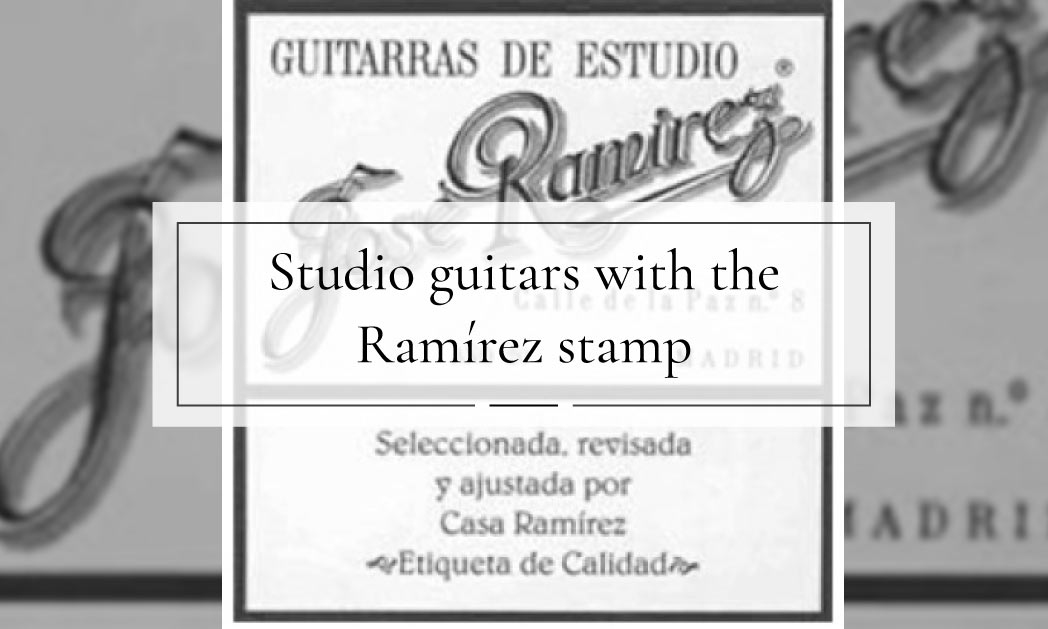When my great-grand father, José Ramírez I, opened his shop in 1882, he did not only sell the guitars done in his workshop (there were different prices according to the complexity of its construction and the quality of the materials) but he also sold a selection of studio models made in factories, with much more affordable prices, thus offering a wide range of possibilities for the customers according to their preferences and economic availability. Moreover, due to their comfort, they are more adequate for beginners than professional guitars.
Labels on studio guitars
Studio guitars, made in factories, were always revised and adjusted in his workshop to make sure that they had quality enough to be sold.
At the beginning, only guitars constructed in his workshop had his label, in studio guitars the label of the manufacturer was kept. However, he started to have problems when some customers came complaining about flaws in their guitars, assuring they had been bought in his shop.
As they had the manufacturer label and not his and even if he was sure that he had not sold any guitar in bad condition, he could not prove it, so he chose to put a label specially designed for those models. This way, the label with his name was warranty that these guitars had been sold in his shop and their quality was backed-up.
Since then, we have continued doing the same. This way we make sure that these guitars have not only been sold in our shop, but also they have gone through a quality control and we have adjusted, touched up and revised them to leave them in good condition to sell them according to our quality standards.
Studio guitars with Ramírez stamp
My grandfather, José Ramírez II, ordered some models especially made for him to Vicente Tatay, a manufacturer of the time; they were sold in our shop for quite some time although I haven’t got the exact dates. They were no longer made in the 50’s, except for one model that was kept until the 70’s. There were three models:
- Model 76, it was small, for 6-7 year olds.
- Model 78, slightly bigger than the previous.
- And model 21 of a regular size.
It was in 1986, when my brother José Ramírez IV convinced our father, José Ramírez III, of the importance of having a series of studio models designed by ourselves, as it was a way to completely guarantee Ramírez quality to students and amateurs that wanted to acquire an appropriate guitar for their level and at a much more reasonable cost than our professional guitars.
This is the way in which E series was born, afterwards I revised it and made some changes to improve the models and this is the present NEseries. My brother also developed R series at the beginning of the 90’s and I have been revising it aiming to get better.
We have other studio models designed by ourselves such as the GH and the NCWE series among others. However, it is not my intention here to make a list of our studio models, but to clarify a situation that we have found to be subjected to misunderstandings and misinterpretations.
Taking care of all the details of our studio guitars
But the point being made here is that we have established some agreements with Spanish factories; we give them our designs so that they make our studio models according to our instructions and special quality requirements. This fact implies that, although a considerable part of their manufacture is mechanized, the most delicate processes are hand made by the most skilled workers. Accordingly, the aforementioned manufacturers have assumed a special commitment of exclusiveness and confidentiality with us.
Therefore, our models are completely out of their regular line of production and they are treated differently. Once they are finished, they are sent to our workshop where we revise, check and adjust them. All this involves an extra charge in their price.
These are cooperation systems that are carried out, in different ways, in different sectors of industry, such as motor industry of fashion. Higher range models are one thing and standard models quite another; or couture designs and prêt-a-porter ones, just to use the language of the aforementioned sectors.
For instance, there are leading car brands that, in order to revitalize the market collaborate with second line brands and create a model with the materials of the first brand but with more simple details, meaning that they are launched with much more economic prices. In the fashion world, couture designs are handmade in the workshops of big fashion houses, and at the same time they create prêt-a-porter models that are made in external factories.
Thus, we currently have three main options:
- On the one hand we have our higher range models, completely handmade in our workshop.
- On the other hand we have our, let’s say, prêt-a-porter models, that we design and are exclusively fabricated for us in Spanish factories exclusively.
- And finally, we have for sale in our shop white-label guitars; they are a selection of different models made by Spanish manufacturers, although they are not our own designs we choose them because we consider they are eligible to be sold in our shops; we always revise and adjust them before we deliver them to our customers and their guarantee is our label.
Article written by Amalia Ramírez


